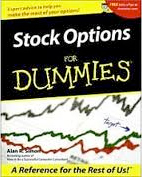Covered Calls For Dummies
There is no book called Covered Calls For Dummies. But that's okay becuase you don't need one. Everything you need is right here in this tutorial. By the time you have finished reading this tutorial you will have a very good understanding of how covered calls work. It's so easy that dummies and non-dummies can do it equally well!
The two types of options (puts and calls) have a lot in common. Here are some basic parameters:
A single option contract controls 100 shares of stock.
But, options are quoted in the market on a per-share basis so when you see an option price quoted at $1.60 that means it's $160 per option contract (because each contract controls 100 shares).
If you owned 100 shares of stock, you could sell 1 call option against it and receive $160.
If you owned 400 shares of stock, you could sell 4 call options against it (not 400 call options) and receive 4 x $160, or $640.
And, if you own less than 100 shares of stock you can't create a covered call position from it.

Options (calls and puts) have 3 attributes to identify them:
- the underlying stock they represent
- the expiration date
- the strike (or exercise) price
Monthly options expire on the Saturday after the third Friday of their expiration month. No reason. They just do (so the Chicago Board Options Exchange (CBOE) says). The last day options trade is the day before they expire (i.e. they stop trading on the third Friday of the month).
Strike prices are usually available in $5 increments, or in $2.50 increments for lower priced stocks, or in $10 increments for high priced stocks. Some actively traded stocks have strikes in $1 increments. (You don't need to know all this; we'll show you all of the available choices in our tables.)
There are over 160,000 call options available with different combinations of month, stock, and strike price, but for some stocks, some months, and some strike prices, there aren't any options available. The CBOE decides which options are available. You will see "-" in our tables if an option is not available.
Another way to have covered calls for dummies explained (after you're done with this tutorial) is to read through our covered call blog.
